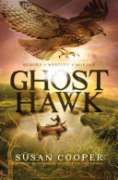
Ghost Hawk
Written by Susan Cooper
New York: Margaret McElderry Books pp. 328
ISBN 978-1442481411
Ghost Hawk has received a starred review in Booklist and was listed as one of the 2013 Booklist’s Editors’ Choice Top of the List: The Best of Editor’s Choice. Despite these awards, this book has problematic aspects.
The story has three parts all of which are narrated by a Native boy, Little Hawk. The first two parts take place in the 17th century and are focused on encounters between the Pilgrims and Native people. The first part tells the story of Little Hawk. Little Hawk and his grandmother are the only survivors of a disease that is brought by the whites and that obliterates many native villages. In their new village, Little Hawk meets a Pilgrim boy, John. At the end of part one, Little Hawk is shot by a Pilgrim and becomes a spirit. He says, “I can see past and present, though not future. I can hear speech and thought no matter what its language. I may not intervene. I may be seen, if I choose, and I may communicate, if I choose, but only in a certain place, and at certain times.” John is able to see and talk to Little Hawk at dawn and sunset if he goes to an island off the coast. There Little Hawk teaches John his native language, Wampanoag, and instructs him about the culture of his people.
In his narration, Little Hawk observes and tells what happened to his people as well as what happens to John as he matures and becomes a leader in a new community apart from the rigid Pilgrims. Part three takes place in contemporary times. A woman comes to live on the island where she sees Little Hawk’s ghost, and finds a way to release his spirit. Cooper’s Author’s Note explains how she built a house on Little Hawk’s island. She writes, “It is not possible to live here without listening to the land and its past, and so I found myself writing this book. … The story is a work of the imagination: not a historical novel, but a fantasy set within a historical background.”
Several aspects of the story were difficult for me to accept. First, when Little Hawk is killed, John feels responsible because he called for help and Little Hawk came to his father’s rescue. In doing so, Little Hawk is killed by a Pilgrim who comes on the scene thinking Little Hawk is attacking the father. John’s father dies, yet John is more distraught over the injustice of Little Hawk’s death. John is more saddened by Little Hawk’s death than his father’s death.
Another part of the story that is difficult to believe has to do with how the ghost of Little Hawk teaches John his language and culture. These teachings can only occur in the short spaces where the spirit can communicate and be seen during sunrise and sunset. Furthermore, John can only get away to travel to the island a few times. Yet he becomes a fluent speaker of Wampanoag and acquires an in-depth knowledge of the culture.
The authenticity of Native cultural descriptions in the book is also a concern. Cooper writes in her Author’s Note that her research included Nathaniel Philbrick’s Mayflower, which provided a portrait of the period about the Pilgrims. The Pilgrim part of the story seems accurate; however, it is not clear how she undertook her research about the Native people in that area, the Wampanoag. What she imagines about their life appears to rely on stereotypes, since there are few if any records about this group at that time. Debbie Reese critiques the portrayal of Native people of Ghost Hawk in her blog, American Indians in Children’s Literature. She writes, “From my point of view, Cooper took many liberties in the ways that she portrays Native peoples in Ghost Hawk.” Her blog details her many objections to the book.
Cooper is a master of her craft. Her writing is lyrical and descriptive of the beautiful settings, making obvious why she has been honored with a Newbery Award and a Newbery Honor. In addition, she has been honored for her body of work by the American Library Association with the Margaret Edwards Award in 2012. However, despite her strong writing, the problematic aspects of her book raise questions about the starred reviews and whether reviewers considered issues of authenticity.
Share Louise Erdrich’s books of historical fiction with children for a more thoughtful portrayal of Native People. Erdrich’s historical series begins with The Birchbark House (2002) and continues with The Game of Silence (2006), The Porcupine Year (2010) and Chickadee (2013). The stories about an Ojibwa family balance the portrayals of Native Americans in Cooper’s book. Other Native American authors like, Michael Dorris and Joseph Bruchac have also written fine historical fiction about the Native American experience
Marilyn Carpenter, Eastern Washington University, Spokane, WA
WOW Review, Volume VI, Issue 3 by Worlds of Words is licensed under a Creative Commons Attribution-NonCommercial-ShareAlike 4.0 International License. Based on work at https://wowlit.org/on-line-publications/review/vi-3/
